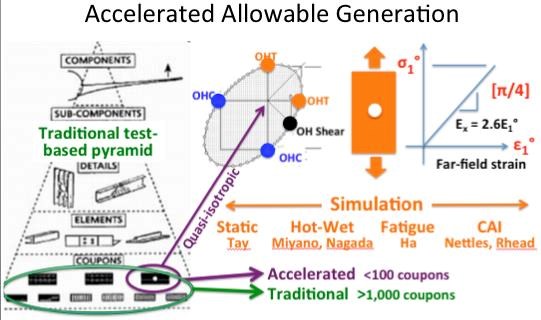Cutting time for composites design allowables
New approach by Dr. Stephen Tsai and Daniel Melo promises to reduce the required number of tests from 1,000 to mere dozens, providing results in days vs. months and at much lower cost.

New vs. traditional approach to design allowables.
SOURCE: Dr. Stephen W. Tsai and Jose Daniel D. Melo.
HPC reported on this new approach in the July issue: “Overnight design allowables? An invariant-based method for accelerating aerospace certification testing.” For more details and the full series of charts and graphs, see the white paper from Dr. Tsai and Daniel Melo posted on CW’s White Papers page.
Dr. Tsai comments, “The recognition of invariants that can significantly simplify design and testing of composites structures was discovered by Daniel and me by accident. The number of tests for design allowable generation can be reduced from one thousand to a few dozen if not fewer. More importantly, key tests can be made a matter of hours instead of days, weeks or months.” He adds that the only stiffness data needed is the value of trace, a sum of the diagonal components of the stiffness matrix. “For strength, one tensile or compressive strength of open hole coupons at room temperature can be sufficient to generate allowables, and the accelerated testing of fatigue strength can also be done based on the shift factor of viscoelastic behavior of composites.”
To put it more in layman’s terms and get a critical review, I asked Dr. Rik Heslehurst to read and comment on the white paper. Heslehurst is a former aeronautical engineering officer in the Royal Australian Air Force (RAAF), in charge of material and process engineering for almost two decades. He also instructs advanced composite engineering courses for Abaris Training (Reno, Nevada) and has consulted for a wide variety of companies including Boeing, the U.S. Air Force, Lockheed Martin and Bombardier. Heslehurst’s response:
"The basic premise is that all composite materials (plies and laminates) have a stiffness relationship that is essentially invariant (statistically low variation). This invariant term is called TRACE. With knowledge of the axial longitudinal modulus value for any composite material the TRACE factor can be determined and the resulting stiffness matrix of a ply and thus a laminate can be determined. This approach is a significant and positive step in reducing the cost of determining materials allowables.
I would caution, however, that the assumptions made, such as the major Poisson’s ratio as 0.3 and the derivation of the shear modulus term, require a sufficient knowledge of composite materials properties computation as well as design allowables generation — for example, the differences between that for unidirectional tape and cloth.
I believe that the development of the shift factors for open hole, environmental and fatigue is also a very positive step, and fortunately, there is now extensive materials data available on these effects to allow close comparison with simulated data.
I am encouraged by the approach and already see several applications in my own work that will allow early and rapid development of composite designs, but I would reiterate that a novice not use this approach without due understanding and caution."
The foundation of invariants and implications on composites design allowables testing will be covered extensively by several speakers in the upcoming Composites Durability Workshop 19 (July 27-29) hosted by Stanford University’s Department of Aeronautics & Astronautics (Stanford, Calif., USA).
Proposed advances that can simplify design allowables generation will be presented by representatives of Stanford, Wichita and other universities, as well as end users and the FAA. Potential issues in expanding the adoption of this approach will also be discussed and help in using tools and templates for one master ply will be available during and after workshop.
A formal technical paper, “An invariant-based theory of composites,” has just been published online in the journal Composites Science and Technology.
Related Content
TPRC training courses target thermoplastic composites
Three upcoming in-person thermoplastic composites courses, ranging from entry-level to advanced, are organized to enhance composites professionals’ knowledge in this burgeoning field.
Read MoreAutomated filament winding system increases throughput, reduces manual labor for pressurized well tank production
For its new line of composite well water tanks, Amtrol worked with Roth Composite Machinery on an automated process for faster, more easily tracked production.
Read More9T Labs, Purdue University to advance composites use in structural aerospace applications
Partnership defines new standard of accessibility to produce 3D-printed structural composite parts as easily as metal alternatives via Additive Fusion Technology, workflow tools.
Read MoreMaterials & Processes: Fabrication methods
There are numerous methods for fabricating composite components. Selection of a method for a particular part, therefore, will depend on the materials, the part design and end-use or application. Here's a guide to selection.
Read MoreRead Next
From the CW Archives: The tale of the thermoplastic cryotank
In 2006, guest columnist Bob Hartunian related the story of his efforts two decades prior, while at McDonnell Douglas, to develop a thermoplastic composite crytank for hydrogen storage. He learned a lot of lessons.
Read MoreCW’s 2024 Top Shops survey offers new approach to benchmarking
Respondents that complete the survey by April 30, 2024, have the chance to be recognized as an honoree.
Read MoreComposites end markets: Energy (2024)
Composites are used widely in oil/gas, wind and other renewable energy applications. Despite market challenges, growth potential and innovation for composites continue.
Read More















.jpg;maxWidth=300;quality=90)










